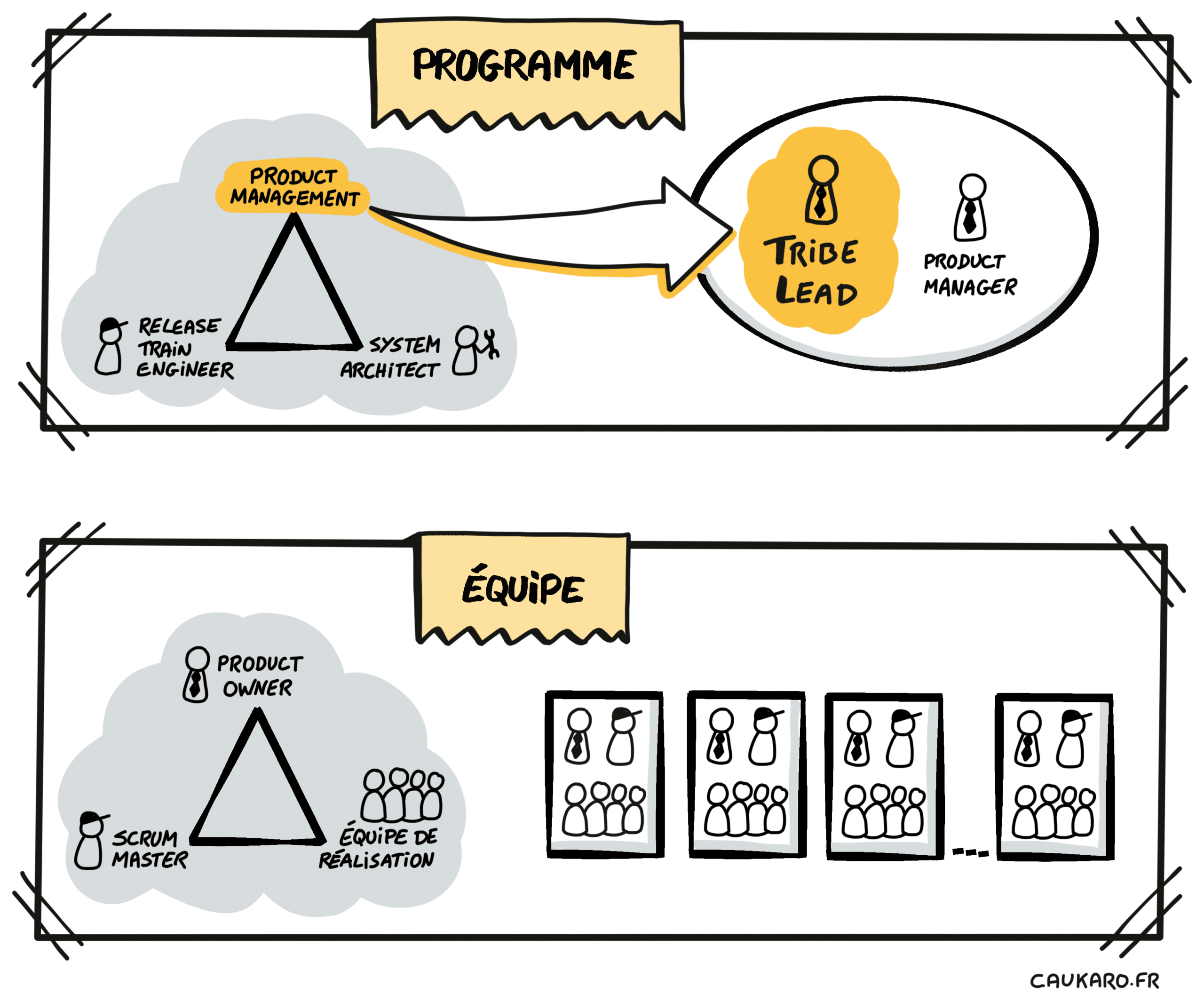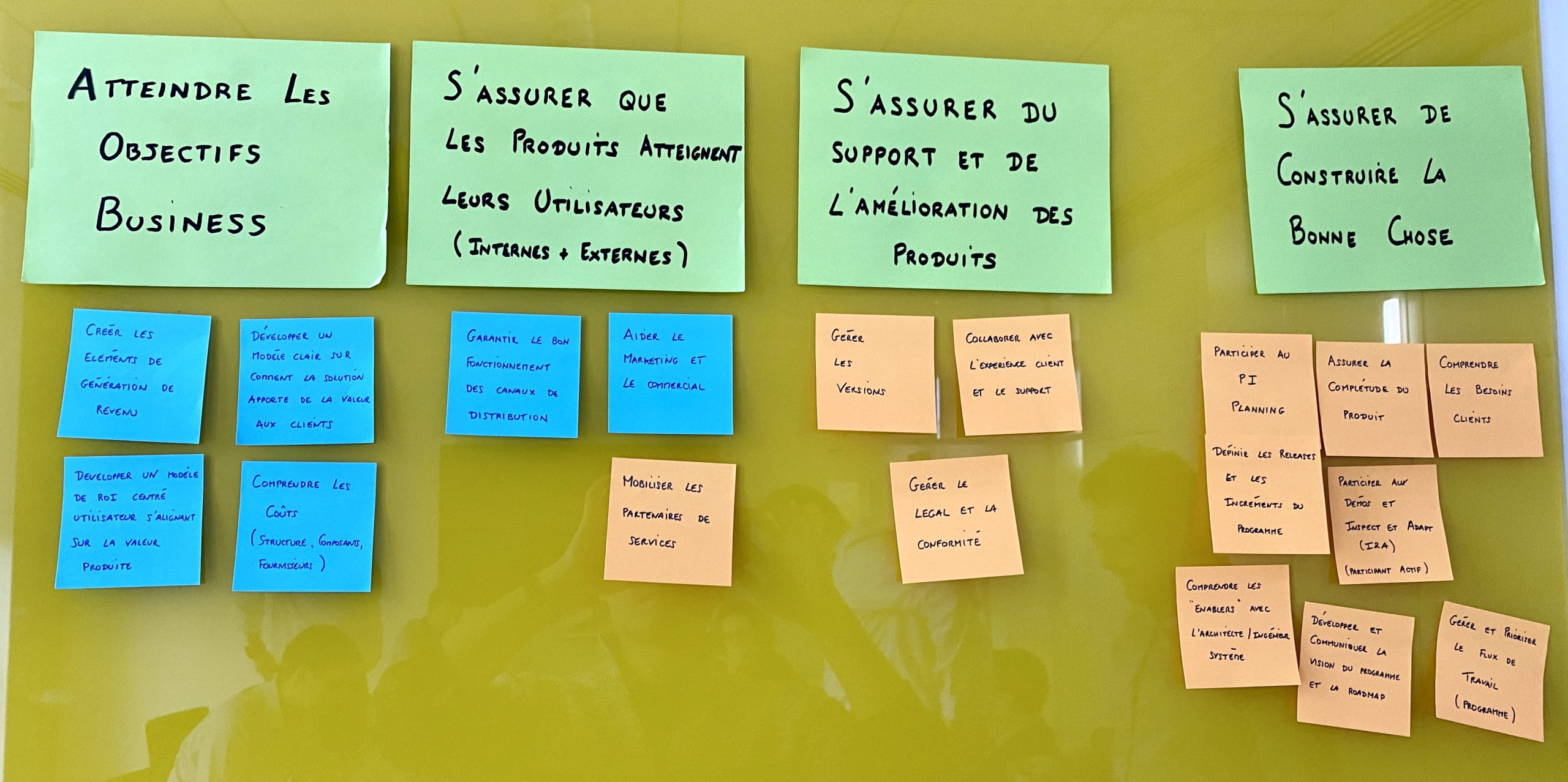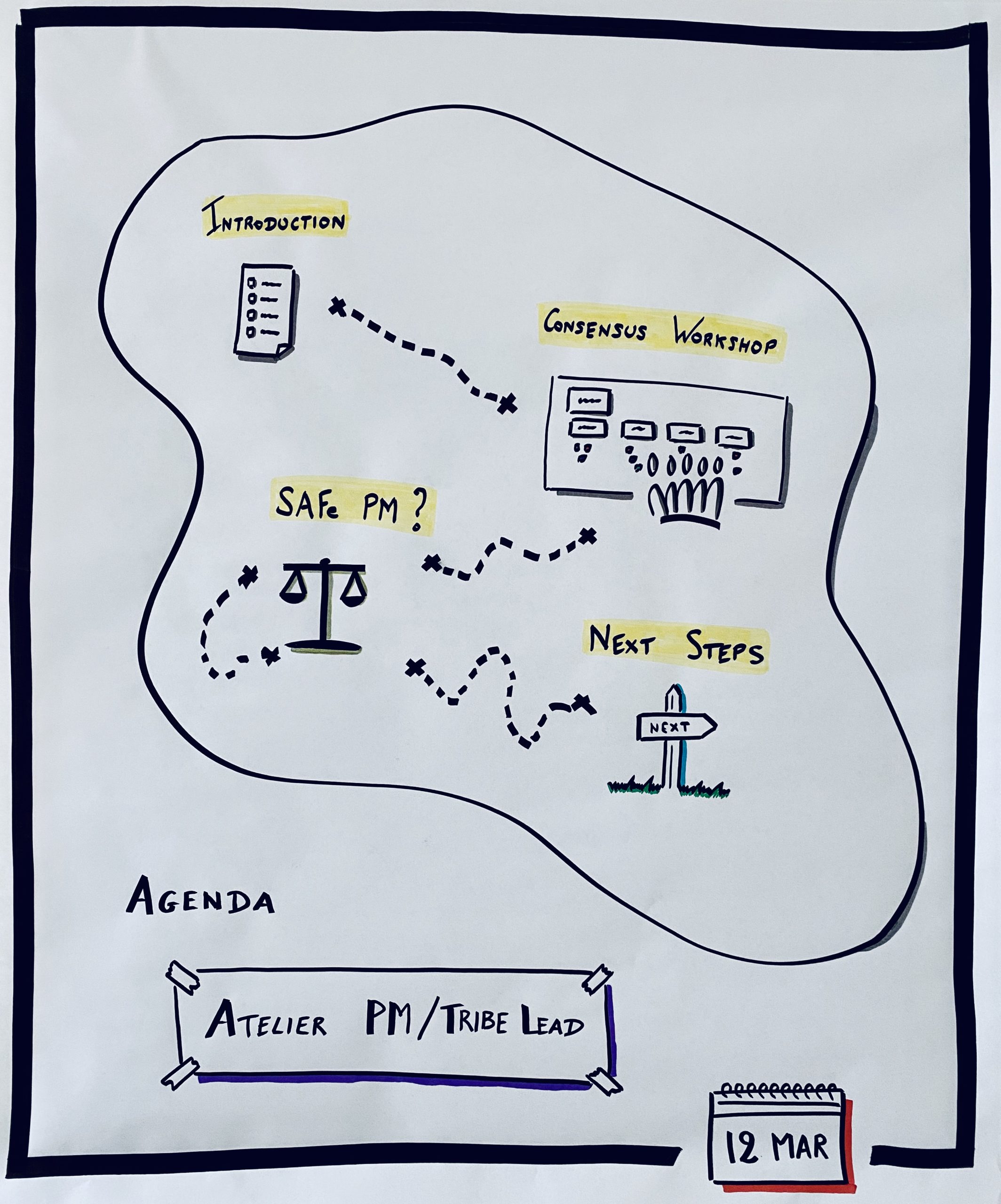Transformation Agile petite ou grande échelle, la question des rôles est une problématique assez commune. Pas qu’elle m’apparaisse comme normale, mais souvent car c’est la manière la plus rassurante de changer, j’ai l’impression.
Dans mon cas, c’est le flou instauré sur un rôle en particulier qui a généré quelques tensions et qui m’a amené à prendre la main sur une série d’ateliers de clarification : l’opportunité pour moi de montrer à mon client comment animer différemment ce genre de « réunions » et de donner un regard différent sur la transformation.
Voici ce qu’il s’est passé.
| Note : l’atelier ayant eu lieu avant le confinement, il y a donc encore des Post-it en papier (et ça fait plaisir). Cependant, le mode opératoire pourrait également fonctionner à distance moyennant quelques ajustements. |
Contexte
 Schéma d’organisation
Schéma d’organisation
Je travaille actuellement dans un contexte de mise en place d’Agilité à l’échelle, fortement inspiré par SAFe et mené par un groupe assez conséquent de consultants en transformation.
Dans ce cadre, nous avons donc une couche « Équipe » et une couche « Programme » avec en particulier un Product Management représenté par un comité composé d’une personne de l’IT et une personne du Métier. Dans une logique qui m’échappe encore, même si la source d’inspiration est assez claire, la personne de l’IT a été appelée Chef de Tribu ou encore « Tribe Lead« . C’est ce rôle qui a dernièrement posé quelques problèmes, générant ainsi des tensions entre les différentes couches de l’organisation.
Il m’est apparu intéressant de voir que cet écueil apparaisse maintenant alors que cela faisait déjà bien 3 mois que des présentations du rôle avaient été effectuées par les consultants en transformation. C’était donc là une bonne opportunité pour avoir une démarche un peu différente, basée sur de l’intelligence collective, plutôt que sur de l’information descendante et quelques fois ressentie comme imposée.
C’est lors d’une réunion hebdomadaire avec les membres clés du management que nous avons décidé d’organiser un atelier de clarification autour de ce rôle, réunissant les personnes alors présentes dans la salle. En prenant en compte les agendas et l’urgence du sujet, nous nous sommes mis d’accord à 19h de faire l’atelier le lendemain à 9h30.
J’ai donc décidé de prendre la main pour pouvoir :
- Montrer comment animer des ateliers / réunions autrement
- Montrer que l’application non informée d’un framework n’a pas beaucoup de sens et que le contexte est important à prendre en compte
Malgré ces challenges motivants, je sentais néanmoins que la nuit allait être un peu longue ou que le réveil sonnerait un peu tôt ! 😛
Conception

Avec les éléments précédents bien en tête :
- je propose un atelier d’1h30 en me disant que l’on pourrait finir plus tôt. En effet, dans un cas comme celui-ci, je préfère prendre plus de temps quitte à finir plus tôt que de manquer de temps et que chacun reste sur sa fin.
- je considère le nombre de participants entre 4 et 8 personnes, des personnes projetant de ne venir qu’en fin d’atelier.
On peut juste repartir de la liste d’activités associées au Product Management de SAFe et puis voilà !
Voici ce que l’on m’a dit en partant vers 19h. C’est une idée effectivement, mais quelque chose me dit que cela risque de ne pas être aussi simple. Je me rends alors sur la page dédiée au Product et Solution Management de SAFe pour me faire une idée et pour le coup, je ne suis pas déçu.
En effet, le rôle théorique comprend 4 grandes responsabilités ou missions :
- Atteindre les Objectifs Business
- S’assurer que les produits atteignent leurs Utilisateurs (Internes et Externes)
- S’assurer du Support et de l’Amélioration des produits
- S’assurer de construire la Bonne Chose
| Note : ces éléments sont le fruit de ma traduction rapide à une heure un peu tardive, désolé ! 🙂 |
Chacune se décompose alors entre 3 à 8 activités permettant de préciser un peu mieux ce que l’on attend.
Après une lecture attentive de l’ensemble, je me dis que mon client est bien loin de tout cela et que d’en faire une base pour l’atelier n’aurait peut-être pas beaucoup de sens. Je vais donc partir dans une autre direction mais peut-être que cette recherche peut s’avérer néanmoins utile ! 😉
1. Consensus Workshop
J’opte alors dans un premier temps pour un Consensus Workshop permettant aux participant(e)s de confronter leurs perceptions du rôle.
En effet, l’intérêt sera double :
- leur permettre de s’aligner sur une vision commune,
- tout en prenant en compte les spécificités de leur propre contexte.
Ils répondront alors à la question suivante :
Quelles sont les activités du Product Management / Tribe Lead ?
| Note : j’ai gardé la notion de Product Management car il me paraissait intéressant de voir comment ce rôle au sens large était perçu. Même si cela peut flouter un peu la question, j’ai considéré que chaque personne répondrait à ce qu’il ou elle comprend. |
2. Comparaison avec SAFe PM
Afin de mettre à profit ma recherche précédente, je leur proposerai de comparer leur vision du rôle de Tribe Lead/PM avec la vision théorique de SAFe. Cela sera une bonne manière pour eux de voir quels en sont les points communs, les différences et surtout ce qu’ils souhaitent en garder ou pas.
Nous serons donc bien ici dans une démarche de prise de décision informée, responsabilisante, prenant en compte les contraintes spécifiques du contexte et non pas mécanique d’application théorique d’un modèle.
3. Next Steps
En clôture, nous déciderons ensemble des prochaines étapes à mettre en oeuvre pour pouvoir actionner ce résultat obtenu collectivement. L’occasion de récupérer dans le même temps des feedbacks sur le déroulé de l’atelier.
Préparation
Comme tout atelier, la préparation est primordiale. Je m’attèle alors à préparer les différentes phases, l’occasion de m’assurer que la mécanique reste fluide et cohérente. Tout cela commence donc par l’Agenda 🙂
Consensus Workshop

La préparation du Consensus Workshop est assez simple :
- Préparer la question pour la rendre visible de tous (Post-it Rose)
- Préparer quelques espaces pour structurer le travail de catégorisation (Post-it Vert)
- Préparer les blocs de Post-it et un feutre par personne pour la phase de recueil de données
| Note : j’ai eu la possibilité de trouver des Post-it au format A5 que je trouve très appréciable pour ce genre d’exercice ! Le fait qu’il y ait 5 espaces est totalement arbitraire quoique pas exactement – c’était l’espace de mur disponible en largeur je crois 🙂 |
Comparaison avec SAFe PM

Pour effectuer la comparaison le plus efficacement possible, j’ai décidé de partir sur les mêmes codes couleur que le Consensus Workshop. J’écris alors les missions du PM sur Post-it A5 Vert et les activités sur des Post-it carrés normaux.
Étant chez un client travaillant principalement en français, je me suis lancé dans la traduction des missions et activités pour éviter les problématiques de compréhension dans les échanges (ce qu’on ne fait pas pour la réussite d’un atelier n’est-ce pas ? :-P).
| Note : les couleurs des Post-it carrés n’ont pas de signification particulière. |
Pour ne pas les laisser à la vue de tous, je vais y coller l’agenda fait sur Post-it Géant par dessus en début des session. L’idée sera de dévoiler ces éléments uniquement dans la phase concernée : oui, j’ai eu envie de faire un peu le spectacle ! 🙂
Animation

Nous en arrivons donc à l’heure de l’atelier. Bien évidemment, les participant(e)s ont du retard et nous ne commencerons que vers 9h40. Ils ne seront finalement que 4 dans un premier temps.
Après avoir expliqué l’agenda de l’atelier et les différentes séquences à l’aide du support visuel, nous partons sur le Consensus Workshop.
1. Consensus Workshop
Après avoir rappelé la question, je leur propose la mécanique suivante :
- 2 minutes de réflexion individuelle
Je trouve qu’une minute est en général trop court sauf pour les personnes qui ont l’habitude, et encore. En effet, il y a souvent un temps de latence au démarrage qui peut déjà prendre de l’ordre de 15 à 20 secondes pour se mettre dans l’exercice.
- 5 minutes de réflexion en binôme, où l’on supprime les doublons
Pour la première fois dans ce genre d’animation, on m’a demandé :
Est-ce qu’on ne pourrait pas tout de suite mettre nos réponses sur le tableau plutôt ?
Je me suis surpris moi-même à répondre de manière un peu automatique :
Non.
En effet, avec le recul, je pense que j’ai ressenti la question comme une tentative de la personne d’arrêter de travailler : l’habitude étant plutôt d’être assis autour de la table et de débattre, sans structure. Je ne dis pas que c’était son intention mais bien que c’était ma perception du moment 🙂
J’ai ajouté néanmoins :
Il est important dans le processus de faire ce travail en binôme afin de faire un filtrage utile de vos résultats pour le reste du groupe. Je vous invite à l’expérimenter ! 🙂
Tout s’est bien déroulé par la suite, les échanges semblant d’ailleurs plutôt engagés.
- Partage en groupe complet
Pour le débriefing en groupe complet, les instructions furent plutôt simples, n’ayant à faire qu’à 2 binômes : chaque groupe expose ses Post-its un à un, s’il semble appartenir à la même catégorie qu’un autre on les place sous le même Post-it A5 Vert, sinon on choisit une autre colonne.
Après avoir dépilé l’ensemble des Post-its, nous travaillons sur le nommage des différentes catégories ainsi construites. Cela amène à des échanges très intéressants, à des changements dans les regroupements pour enfin arriver à 5 catégories distinctes, dont 1 correspondant à des questionnements.
Le résultat obtenu fut le suivant :

Ce que l’on peut voir est qu’une des catégories, intitulée « Reporting & Représentation », est pour le coup très spécifique au contexte client. En effet, les activités recensées ici sont pour la plupart issues de modes de fonctionnement internes, toujours d’actualité, mais qui n’apparaissent nulle part dans les ressources Agile (et c’est normal).
Cette dernière phase a amené à une meilleure compréhension des enjeux du rôle et de ses contraintes aux participant(e)s, en prenant en compte les spécificités de leur propre contexte.
Comparons maintenant ces résultats à la théorie SAFe.
2. Comparaison SAFe PM
Comme prévu, je dévoile les Post-its cachés sous l’agenda pour cette séquence et j’entends avec plaisir un « Waouh » de surprise de la part des participants. Ils ne semblaient pas s’y attendre et l’effet coloré du contenu a peut-être fait son effet ! 😛
Je présente la démarche que j’ai eue pour en arriver à ce résultat et leur présente donc par la suite ce que SAFe préconise pour le rôle de PM, théoriquement.
Après quelques échanges, nous convenons ensemble que le rôle de Tribe Lead ne correspond en fait qu’à 1/4 du rôle de PM au sens SAFe. En effet, les parties restantes devant être prises par le métier.
Cela fut une belle découverte pour les participants mais surtout une clarification d’où ils se situaient aujourd’hui : nous allons pouvoir ainsi définir ensemble là où l’on souhaite aller par la suite.
3. Next Steps
Suite aux résultats obtenus dans les séquences précédentes, nous décidons alors des étapes suivantes :
- Organiser un atelier du même type avec les Tribe Leads : pour confronter leurs visions à la vision obtenue ce jour
- Organiser pour chaque Tribe Lead un entretien individuel avec son Management : afin de lui permettre d’exprimer ses inquiétudes ou autres aspects peut-être plus difficiles à partager en groupe
- Organiser potentiellement un entretien avec un coach : pour échanger autour de sa posture en tant que leader Agile dans une organisation telle que mise en place actuellement
Conclusion

La compréhension et l’application de nouveaux rôles est toujours un défi. Cela est d’autant plus vrai dans une démarche d’Agilité à l’échelle où ces derniers se voient souvent démultipliés. Maintenant, il est important de garder en tête que ce ne sont pas tant les rôles qui sont importants mais leur utilité dans le système organisationnel global.
Pour s’assurer que tout le monde puisse trouver sa place, il me paraît nécessaire de les inclure dans la solution plutôt que de la leur imposer, surtout si elle ne prend pas en compte les contraintes du contexte à un instant t.
Ainsi, malgré une structure d’animation plutôt simple, je pense que cet atelier fut apprécié par les participants. En effet, j’ai eu l’occasion de recevoir plusieurs éloges de la part du « grand chef » arrivé en fin de session sur la qualité de l’animation mais également de la part d’autres participants qui ont été agréablement surpris par le format.
Cela fait toujours plaisir, bien sûr, mais je pense que c’est surtout une belle opportunité pour faire évoluer les pratiques pour des réunions plus utiles et plus efficaces ! 🙂
Le prochain article décrira l’atelier avec les Tribe Leads effectué après l’annonce du confinement : une expérience de facilitation à distance un peu difficile !








Une réponse
Merci très intéressant ! j’ai déjà utilisé une méthode de définition de rôles appelée « matrice des attendus », mais celle-ci me parait encore plus complète et permettant de creuser davantage le détail des missions. Hate de voir le prochain article!